#aluminum oxide uses
Explore tagged Tumblr posts
Text
“I gathered all vaccine ingredients into a list and contacted Poison Control. After intros and such, and asking to speak with someone tenured and knowledgeable, this is the gist of that conversation.
Me: My question to you is how are these ingredients categorized? As benign or poison? (I ran a few ingredients, formaldehyde, Tween 80, mercury, aluminum, phenoxyethanol, potassium phosphate, sodium phosphate, sorbitol, etc.)
He: Well, that's quite a list... But I'd have to easily say that they're all toxic to humans... Used in fertilizers... Pesticides... To stop the heart... To preserve a dead body... They're registered with us in different categories, but pretty much poisons. Why?
Me: If I were deliberately to feed or inject my child with these ingredients often, as a schedule, obviously I'd put my daughter in harm's way... But what would legally happen to me?
He: Odd question... But you'd likely be charged with criminal negligence... perhaps with intent to kill... and of course child abuse... Your child would be taken away from you... Do you know of someone's who's doing this to their child? This is criminal...
Me: An industry... These are the ingredients used in vaccines... With binding agents to make sure the body won't flush these out... To keep the antibody levels up indefinitely...
The man was beside himself. He asked if I would email him all this information. He wanted to share it with his adult kids who are parents. He was horrified and felt awful he didn't know... his kids are vaccinated and they have health issues...”
~ By Iris Figueroa
Here are just SOME vaccine ingredients present in routine vaccines:
◾️Formaldehyde/Formalin - Highly toxic systematic poison and carcinogen.
◾️Betapropiolactone - Toxic chemical and carcinogen. May cause death/permanant injury after very short exposure to small quantities. Corrosive chemical.
◾️Hexadecyltrimethylammonium bromide - May cause damage to the liver, cardiovascular system, and central nervous system. May cause reproductive effects and birth defects.
◾️Aluminum hydroxide, aluminum phosphate, and aluminum salts - Neurotoxin. Carries risk for long term brain inflammation/swelling, neurological disorders, autoimmune disease, Alzheimer's, dementia, and autism. It penetrates the brain where it persists indefinitely.
◾️Thimerosal (mercury) - Neurotoxin. Induces cellular damage, reduces oxidation-reduction activity, cellular degeneration, and cell death. Linked to neurological disorders, Alzheimer's, dementia, and autism.
◾️Polysorbate 80 & 20 - Trespasses the Blood-Brain Barrier and carries with it aluminum, thimerosal, and viruses; allowing it to enter the brain.
◾️Glutaraldehyde - Toxic chemical used as a disinfectant for heat sensitive medical equipment.
◾️Fetal Bovine Serum - Harvested from bovine (cow) fetuses taken from pregnant cows before slaughter.
◾️Human Diploid Fibroblast Cells - aborted fetal cells. Foreign DNA has the ability to interact with our own.
◾️African Green Monkey Kidney Cells - Can carry the SV-40 cancer-causing virus that has already tainted about 30 million Americans.
◾️Acetone - Can cause kidney, liver, and nerve damage.
◾️E.Coli - Yes, you read that right.
◾️DNA from porcine (pig) Circovirus type-1
◾️Human embryonic lung cell cultures (from aborted fetuses)
You can view all of these ingredients on the CDCs website: 👇
You are always welcome to do your own research, in fact I encourage you to do so. 🤔
#pay attention#educate yourselves#educate yourself#knowledge is power#reeducate yourself#reeducate yourselves#think about it#think for yourselves#think for yourself#do your homework#do your own research#do some research#ask yourself questions#question everything#government corruption#cdc corruption#lies exposed#medical corruption
265 notes
·
View notes
Note
I’m not sure if this is off topic for your blog, but out of fear for my search history and the police, I wanted to ask if there is a means of someone producing a homemade bomb or something throwable that generates high levels of heat?
For context, the character I am writing is a lab intern that is secretly studying how to get rid of a parasite (think of something like Venom/Carnage) that can only be injured/destroyed with high levels of heat.
Two thoughts come to mind immediately, thermite and white phosphorous. So, in both cases, we're going to be setting metals on fire.
Thermite is more of a process than a specific chemical composition, which means getting the materials to make thermite explosives isn't that challenging. It involves getting a highly reactive metal, and then getting it to oxidize aggressively. Turns out, if you force aluminum to rust on the spot, it gets a bit warm. In some cases (such as with copper) the reaction is energetic enough to cause molten metal to splatter.
Because we're talking about different chemical mixtures, it's a bit hard to predict the exact tempreture, but most thermite reactions (at least, all of the ones I've ever looked up) will burn in excess of 2000K (3000F.)
Rigging thermite into a more portable form isn't that complicated, and crude pipe bomb-like containers should get the job done. Though, this would likely cause further problems.
The second option is white phosphorous. This burns at a lower temperature (around 800C), but this stuff ignites on contact with oxygen. Something you might be able to find in the air you're breathing. White phosphorous is a bit more tightly controlled, and is used in a wide variety of munitions. (In theory, it's used for tracers, as the phosphorous will ignite and glow while the round is traveling to its destination.) Because it will continue to burn in the wound, white phosphorous wounds are particularly horrific (as you'll see, if you ever visit the Wikipedia page.) However, it is already available as a payload for most military small arms cartridges.
A third option is classic napalm. This stuff tends to burn north of 800C. The actual material is a bit more disturbing than you might realize. Nalpalm isn't just a burning liquid, it's more like a burning goop, that sticks to whatever it hits... and continues to burn. Imagine a Vaseline sprayer (except, the Vaseline is ignited just after it leaves the nozzle.) Producing napalm in a modern chemlab, with a reasonable stockpile of ingredients shouldn't be too difficult, though it's unlikely the stockroom would have enough of the relevant chemicals to make much of the stuff. (Nalpalm flamethrowers go through a lot of fuel, so making the stuff on site might not be a great option.)
Using any of these methods will get a lot of attention on your character. While we tend to overestimate just how much casual searches for this kind of information are likely to land you on a watch list (this used to be more true than it is today), actually using them in the field will get an anti-terrorism taskforce crawling down around your character's ears. (Especially if they're making thermite loaded pipe bombs.)
Now, here's the funny thing about all of this: It's unnecessary.
You've got a monster that is vulnerable to flames. The simplest, and cheapest solution, is probably to go buy one of those orange, plastic, flare guns. This'll set you back less than $40 dollars (plus the cost of the included flares.) Then load up on extra flares, (at this moment, they're around $10 per flare.) (If you already have a 12 gauge shotgun, you can skip the flare gun entirely, and just buy 12ga flare shells.)
Those flares burn at similar temperatures to white phosphorous rounds, and are much, much, less regulated. (Though, if you're wandering out and buying up hundreds of flare shell rounds, that's likely to raise a few eyebrows.) (This is also true of normal emergency flares, similar temperatures, and they burn for much longer.)
This is without even thinking about Dragon's Breath shells, which will burn in the range of some of the hotter thermite reaction ranges. (To be honest, it probably is a thermite reaction, but I'd need to look into them a bit more to verify that.)
So, ultimately, the problem for a monster vulnerable to heat is that there are a lot of ways to throw burning metal at it, and let that cook it for you.
-Starke
This blog is supported through Patreon. Patrons get access to new posts three days early, and direct access to us through Discord. If you’re already a Patron, thank you. If you’d like to support us, please consider becoming a Patron.
162 notes
·
View notes
Text

Paint it Black! Making one of the first titanium airplanes was difficult .
Titanium was corrugated to make room for expansion when the titanium heated up at top speed of 2200+ mph. The skin panels were fastened to the underlying structure with oblong holes which would allow the skin to expand and contract without the fasteners causing buckling. And the skin over the wing was also corrugated to prevent warping during expansion, this is actually quite noticeable, you can see the sections that are corrugated quite clearly here in this artistic photo.
Titanium makes up 93% of the SR 71 structure. It’s strength to weight ratio, or specific strength, is better than Aluminium. Yet today very little titanium is used in everyday objects. Planes primarily use aluminum, not titanium.. why is it not used?
The development of the A-12 the Skunk Works, a small division of Lockheed discovered that making the blackbird out of titanium was going to be anything but easy
Titanium is expensive because its refinement process is a nightmare. To make Titanium, we start with a feedstock in the form of Titanium Dioxide, with this chemical formula. This oxide ore called rutile can be found in high concentrations in dark sandy soils.
Build the SR-71 the US needed to buy vast quantities of the mineral from the Soviets. To do this they purchased the material through ghost organizations to hide the final destination of the material. One of the companies that were made up was a company to make pizza ovens supposedly… the Russians believed this story!
Had the Soviets known what they were helping build, they would not have sold the material. However, the US likely could have just purchased the material from mines in Australia. This is a relatively common raw material and is primarily used as a white pigment for paints and is even found in sunscreen lotion as ultraviolet radiation blocking pigment.
The primary titanium alloy used in the SR-71 was thirteen percent vanadium, eleven percent chromium, and three percent aluminum. Both Chromium and Aluminium form thermally stable oxide layers on the outer skin of the metal. Which prevents oxygen from diffusing further into the metal and causing it to become more brittle.
Which raises the max operating temperature of the metal!
Vanadium acts as a stabilizer for a crystal structure referred to as the beta phase. This leads to a material with higher tensile strength and better formability. Through trial and error and problems that were solved by the geniuses that worked at the Skunk Works. They discovered that their cadmium plated tools were leaving trace amounts of cadmium on bolts, which would cause galvanic corrosion and cause the bolts to fail. This discovery led to all cadmium tools to be removed from the workshop.
This article just proves what we already know today when people work together and work hard to solve problems. New ground was broken with the formulation of titanium that led to the success of the SR 71 and the tremendous heat and strength that this magnificent airplane needed.
As Ben Rich head engineer and later, he replaced Kelly Johnson as the head skunk said in his book called the Skunk Works. ��’I volunteered some unsolicited advice about how we could use a softer titanium that began to lose its strength at 550° to paint the airplane black
From my college things I remember that good heat absorber was also a good heat emitter it would actually radiate away more heat then it would absorb through thick friction. I calculated the black paint would lowered the wing temperature 35° by radiation think of how much easier it will be to build an airplane using softer titanium.
It was my father Butch Sheffield’s boss Ben Rich, who saved the Blackbird program time and money, with his idea of painting it black.
wisconsinmetaltech.com/titanium-and-t… is my Source and SkunkWorks by Ben Rich
Linda Sheffield
@Habubrats71 via X
#sr 71#sr71#sr 71 blackbird#aircraft#usaf#lockheed aviation#skunkworks#aviation#mach3+#habu#reconnaissance#cold war aircraft
54 notes
·
View notes
Text
Some necklaces and bracelets I made a while ago. Thought I'd post them here for solarpunk aesthetic week 🌿☀️🌻🌿
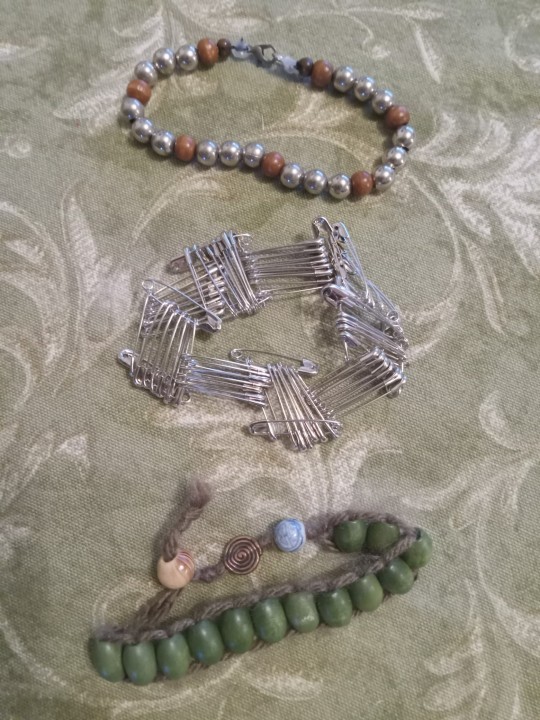



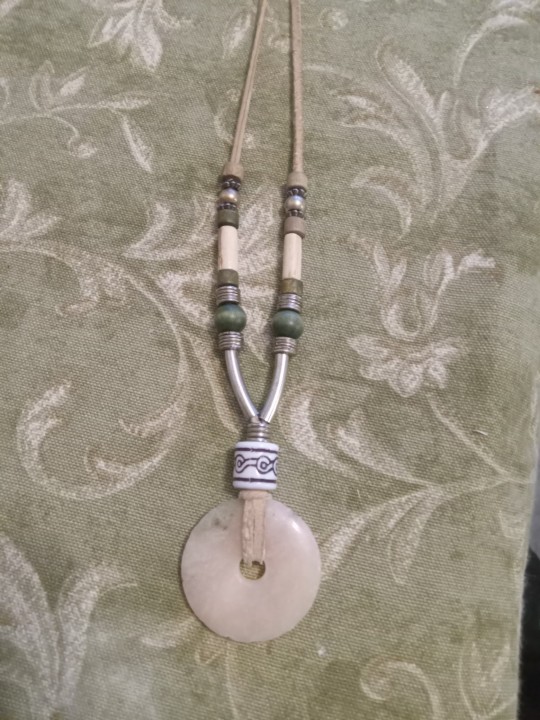

[Image ID: the first image is of three bracelets. One made of three silver metal beads in between one reddish wood bead (thats the pattern), the second is completely made out of safety pins and the last one is made of green wooden oval beads that I weaved yarn through to connect them so they all lay vertically next to each other.
The next image is of a large piece of twine layered over itself, a necklace, with random colorful glass, wood and metal beads scattered all throughout it about an inch apart from each other. They're held in place on the twine with knots so they don't slide around.
The third image is a necklace with a light colored leather cord, with varying colors and shapes of wooden beads on both sides of the pendant. The pendant is an aged gold colored metal sun with a black crystal center. The colors of the beads include dark brown, light brown and in between, with two different sized sphere shapes and lighter tube shaped ones.
The fourth image is of two necklaces almost identical to each other. Both have five small wood beads on both sides of the pendants near the bottom, and multiple small green wood beads tied onto the thin twine cord almost an inch apart from each other. Both pendants are smooth stones, one is a yellow triangle shape and one is a dark grayish blue sharp tooth shape.
The next necklace is on a light colored leather cord. The pendant is a light pink jade donut shaped stone and the beads are varying sizes of wooden beads that are light brown and green with some metal ones in there. The bead closest to the pendant at the bottom holding both sides of the cord together is a white plastic bead with a black spiral design and there are two metal tube beads splitting the cord into two sections, then the rest of the beads are strung up from there
The final necklace is made of varying colors and shapes of steampunk gears. There are bronze, silver and green oxidized copper ones all about the size of a quarter. Some are a little bigger than that. They're all attached to each other in a chain linked together with large silver jump rings and the part that hangs it from the neck is made of silver necklace chain. End ID]
And here's two soda tab arm cuffs I made as well


[Image ID: two images of large bracelets/arm cuffs I weaved out of silver aluminum soda tabs, using black cord. I don't really know how to describe how I made them but it's the same method people use to make soda tab belts as well. End ID]
I have a hard time describing things or wording stuff correctly so I hope my image descriptions are sufficient. If anyone reading my posts can do better, please don't be afraid to add more detailed ones in the reblogs or comment, I will reblog them and/edit my posts to add them as well <3
#solarpunk#solarpunk aesthetic#solarpunk aesthetic week#solarpunk fashion#solarpunk diy#diy#ecopunk#hopepunk#sustainable fashion#sustainability#recycling#jewelry making#jewelry#punk#punk fashion#hatchet makes stuff
203 notes
·
View notes
Text
GEMS
they're truly outrageous, and i just realized i can pin posts now
Hello! If you're here because I made an offhand remark in 2020 about getting a fistful of rubies for $20, I was simplifying very slightly. The lot of rubies that I got are now going for about ~$28, and you can find them here on gemsngems.com.
Do your own due diligence! I've had good experiences with them, I was able to corroborate those experiences with some other reviews online, but your mileage may vary.
FAQ
Q. What's the deal with this company?
A. Best as I can determine, gemsngems is a wholesaler operating out of Bangkok. They supply mass-produced lab-grown gemstones. Because they're operating out of Bangkok, note that international shipping times are probably going to be your enemy. I had to wait for my zircons for like six weeks.
Q. Hey, some of these ruby entries are looking more like $400 for one instead of $20 for ten. What gives?
A. The corundum this supplier has comes from three processes: flame fusion, hydrothermal synthesis, and Czochralski pulling. Flame fusion is cheap and easy, you cram some powdered aluminum oxide and some impurities into a plasma torch and bam, you've got rubies, or sapphires, or spinels, or padparadscha, or whatever. The resulting stones are good enough for me, which is why I bought them.
The hydrothermal process uses a big-ass autoclave to simulate the natural process by which these crystals formed. A saturated solution is put in and allowed to become supersaturated by slowly cooling it. Seed crystals are added to entice things to grow, and you've got pretty damn good stones. Notably, this can be used for things like beryl. It's more time and energy intensive, and that jacks up the price, but the result is basically indistinguishable from natural gemstone.
Czochralski pulling takes a seed crystal and puts it on the end of a puller rod that's dipped into a crucible of molten whatever. The rod is very slowly and precisely pulled upward, resulting in a monocrystalline "ingot" of that whatever. If you're trying to build a laser, don't, but that's kind of the only reason you'd need a gemstone with this kind of purity and structure.
Long story short, if you only need the rocks to look at like a dragon, you're fine with the cheapest option.
Q. Hey, why is there alexandrite listed in the corundum section?
That's simulated alexandrite. It's a corundum that's been doped with a colorant that changes hue from pink to green based on what angle you view it from. You can actually get true beryl alexandrite from this site, but since it's a beryl stone, a great big hunk of it's gonna be pricey, because of the above lecture.
Q. Do you actually have those rubies?
You bet your ass.
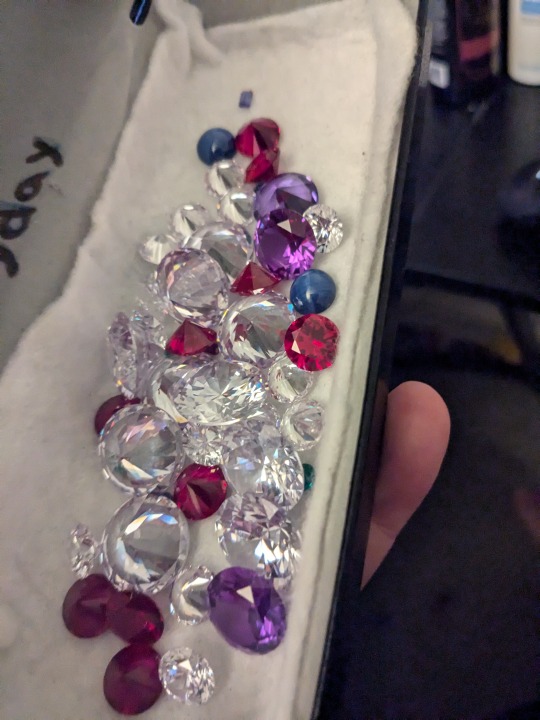
55 notes
·
View notes
Text
As the world continues to experience a worsening climate crisis with record-breaking temperatures, scientists have developed a new, highly reflective glass coating that may help cool a rapidly warming Earth. In theory, the coating — a slurry-like mixture of inexpensive glass and aluminum oxide particles — could reflect high amounts of sunlight off of the surfaces on which it is painted, such as roofs of buildings and roads.
Continue Reading.
118 notes
·
View notes
Text
Do you know? One of my personal Ninjago headcanons is that Kai and Jay are experts in almost everything metalworking.
Just think about it, Kai is a blacksmith so it comes with the job to know about metals, their alloys, the care, what he is for each and type of metal he needs to create 'such a thing.' An example of this is that you cannot use aluminum instead of stainless steel or surgical steel to make a sword, but you can use aluminum to make pots and cover it with an anti-oxidant. While Jay is an inventor/mechanic, so he would know which metals are better conductors, heat absorbent or lightweight in case of making a shell for a machine.
I also imagine them both talking about it and asking each other for advice, or things like they both decided that every time they have to buy something it is Jay who goes since he is precise asking about the metals they need such as inches, thickness and the type, while Kai makes sure that they are of good quality and don't have too many impurities and things like that.
I don't know, I like that they both talk about each other in some way other than just joking and this is something they have in common, even though it's more than just work.
135 notes
·
View notes
Text


The Apollo 4 Lunar Test Article 10R (LTA-10R) at the Manned Spacecraft Operations Building (MSOB) at NASA’s Kennedy Space Center, prior to its assembly and mating with the Spacecraft Lunar Module Adapter (SLA-8).
"Since the objectives of the Apollo 4 mission did not include the LM, a boilerplate model designated LTA-10R was carried instead by SA-501 to simulate the mass and dynamic properties of this part of the payload. With a mass of 13.4 metric tons, LTA-10R consisted of a flight-type LM descent stage without landing gear topped by a ballasted aluminum structure to simulate the ascent stage.

Originally built as LTA-10 by Grumman for use in fit checks and separation tests by North American for its SLA work, it was refurbished to become LTA-10R for use as a flightworthy stand-in for the LM in the Apollo 4 mission. The propellant tanks of the mock descent stage were filled with a water-glycol mixture and Freon to simulate the characteristics of fuel and oxidizer for the LM propulsion system.

Instrumentation mounted on 36 points on LTA-10R would return data on the dynamics of the structure during the first 12 minutes of flight. No flight instrumentation was included in the simulated ascent stage structure. LTA-10R would remain attached to the spent S-IVB stage after separation of the CSM and be destroyed along with the spent stage during reentry over the Pacific."
-Information from drewexmachina.com: link
Date: September 22, 1966
NASA ID: 108P-KSC-66P-450, 108P-KSC-66P-451, S66-56274
Mike Acs's Collection: link
#Apollo 4#Lunar Module Test Article#LTA-10R#Rocket#NASA#Apollo Program#A-type mission#Manned Spacecraft Operations Building#MSOB#Kennedy Space Center#KSC#Florida#September#1966#my post
30 notes
·
View notes
Text

Decomposing 'refrigerants,' a potent greenhouse gas, using industrial waste
A research team has developed a technology to decompose refrigerants, a greenhouse gas 1,300 times more potent than carbon dioxide, using challenging-to-handle industrial waste. Dr. Ryi Shin-kun's team at the Hydrogen Convergence Materials Lab of the Korea Institute of Energy Research (KIER) has successfully developed a catalyst from industrial waste known as "red mud," a byproduct of aluminum production. This catalyst can decompose HFC-134a refrigerant, commonly used in household appliances like air conditioners and refrigerators, with an efficiency of 99%. The study is published in the Journal of Industrial and Engineering Chemistry. Red mud is an industrial byproduct remaining after extracting aluminum oxide from the mineral bauxite. It contains oxides of iron, aluminum, silicon, and other elements, giving it a red color. More than 200,000 tons are produced annually.
Read more.
#Materials Science#Science#Refrigerants#Waste#Catalysts#Red mud#Aluminum#Oxides#Materials processing
22 notes
·
View notes
Text
🧑🏻🔬THE PERIODIC TABLE OF CHEMICAL ELEMENTS👩🏿🔬
(Note: I am not a chemist, just someone who enjoys science, if I made any errors please let me know, thank you and I hope you enjoy reading this)

Ever wonder about this bad boy? While here's a quick crash course on it and some of it groups!
What is it?
The Periodic Table is an arrangement of rows and columns used to display and predict what elements exist and their properties based upon where they fall.
The farther right and down you go, the "heavier" the elements get as they have more Protons, going from 1 Proton for Hydrogen to as of now 118 Protons for Oganesson. Each Collum, excluding the Transition Metals and Rare Earth Series, have similar chemical properties.
Along with this, excluding the Transition Metals, as you go left to right the number of Valence Electrons increases by 1 up to 8 before flipping around back to 1. Valence Electrons can be thought of as the Hands of Atoms, being how they interact and react with each other; a free valence electron spot being a place another atom can bond to like an open hand, while an occupied valence electron spot is like a full hand slapping away other potential electrons.
Each valence group, along with the Transition Metals, builds up the base of all of Chemistry and the universe. So lets have a look at a few of them, shall we?
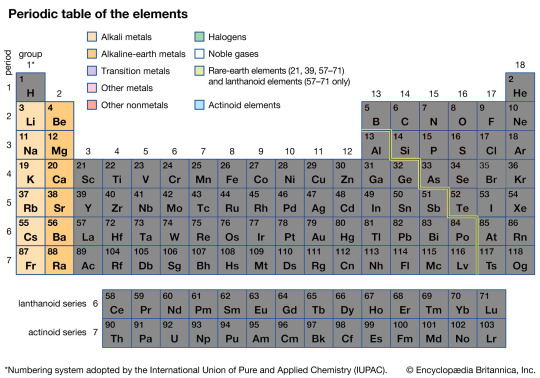
The Alkaline-Earth Metals
The Alkaline-Earth Metals are the two first columns of the Periodic table, and are often sub-divided into the Alkaline Metals and Alkaline Earth Metals. Both groups however do share some properties, often being softer metals that are extremely reactive.
Most famously, they react with water to produce Hydrogen and some heat amount of heat. On the more reactive side such as Lithium and Sodium, this means upon contact with water they will explode, sending red hot metal flying with a violent blast. On the less extreme end such as Magnesium or Calcium, they can be used as ways to produce Hydrogen in small quantities.
Not only are they reactive with water, but also air, oxidizing rapidly in the air and in the case of Magnesium having an extremely violent and energetic reaction when lit on fire.
They also all like to bond with chlorine to produce salts such as Sodium chloride, or more commonly known as humble Table Salt.
After the neat uniformity of the Alkaline-Earth metals, we reach,

The Transition Metals
The Transition Metals are not transgender metals, but rather a large collection of various metals that don't as neatly fit into rows or columns as the other Elemental groupings. Most notably, they have no Valence Electron Shell patterns, meaning you often have to search out the specific Transition Metal you are working with to know how many spots it has still open. They are by far the largest single group of elements within the Periodic Table, and chances are if you think of a metal it will be a transition metal.
It includes some famous stars such as Iron, Gold, Copper, Titanium, Lead, Zinc, Osmium, Tungsten, and Silver. As you can tell from the diverse cast of elements, all of these have wildly varying properties; take the strength and hardness of Iron and Tungsten compared Gold and Zinc as an example.
However they are not totally dissimilar as they are all still metals, meaning they share the properties of Metals. These include high thermal and electrical conductivity, liking to gobble up ions, are highly ductile (the ability to be pulled and bent into wire without breaking), form Cations (positively charged ions), and other such Metal traits.
Truly a party of metals, followed by,

The Other Metals
As the name would suggest, these are some of the other metals and can be thought of as an extension of the Transition Metals.
However their proximity to the other groups gives a few of these metals such as Aluminum more unique chemical behaviors compared to the standard transition metals, which is why sometimes you'll see some disagreement and debate about which ones, if any, should be placed into the next group,

The Metalloids
The Metalloids border between the Metals and the Non Metals, and as such are unique in having properties of both Metals and Non Metals.
Most famous of the Metalloids is arguably Silicon, which makes of the base of the modern world through its semiconductor properties in circuit boards and chips like the one bring used to allow you to read these very words.
Another famous, or perhaps infamous, Metalloid is Arsenic, used in as many poisoning murders for its toxic lethality as paintings and dyes for its beautiful vibrant green hue when turned into a pigment.
And if Arsenic is a bit too deadly for your liking, Gallium is always an option, used in old vacuum tube era computing and lighting. Along with its vintage past, it also has a melting point of 85.58°F or 29.76°C, just shy of room temperature; meaning if you hold a piece of Gallium in your hand, it will melt into a liquid - and unlike Mercury, it is non toxic making it far safer to play with, although it does stick to glass and stain objects so be careful if you do play with it to not let it touch something you don't want getting stained.
And as hinted just before, let us introduce the one and only,
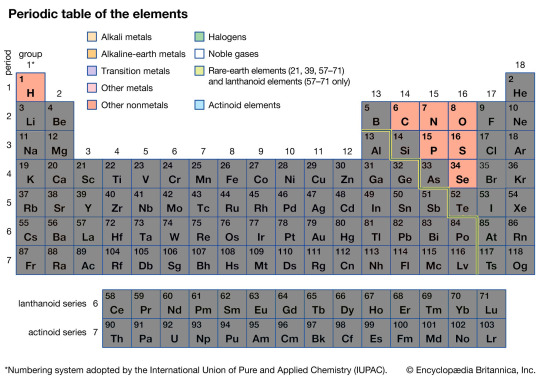
The Non Metals
The Non Metals are a small but extremely unique and important group. All of these elements as the name would suggest sharing the properties of being Non Metals, meaning they are all for the most part poor thermal and electrical conduct, have poor ductility, and form Anions (negatively charged ions).
If you are biologist of any kind, you may also notice this group contains many elements crucial for organic life; the three most important of which without doubt being Carbon, Oxygen, and Hydrogen.
Along with Nitrogen and a few other elements, these elements firm the basis of all life on Earth. From the air you breathe being a Nitrogen-Oxygen mix, to your cells being based on Carbon, to the very DNA that created you. All of it based on Carbon, Oxygen, Nitrogen, and Hydrogen.
And while Oxygen may have taken the honor of the name of Oxidation, it has nothing on the next group,
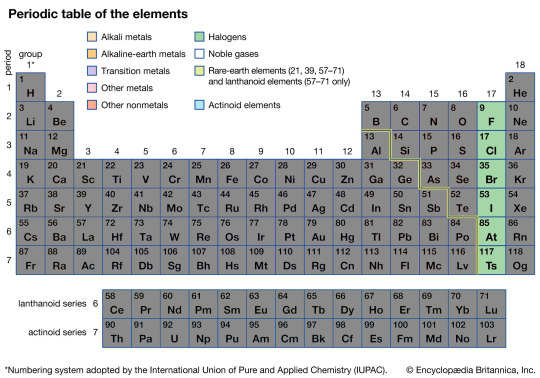
The Halogens
The Halogens, due to missing just one election to be totally stable, are some of the most violently reactive elements on the entire Periodic Table, with Fluorine even known to be able to eat through glass if given enough time.
It might be surprising to hear then that the Halogens also produce some of the most chemically stable compounds known on Earth, such as Polytetrafluoroethylene (PTFE), A.K.A., Teflon. This is because when these elements create compounds they become stable, meaning to break them apart you need an equal amount of energy to do so, and the energy requirement for Halogen compounds is often massive, making them chemically hardy.
Outside of Teflon and eating glass, the less reactive of the Halogens also are used in medicine as a way to sterilize an area. Most commonly and famously used would be Iodine, which not only has a beautiful purple hue, but is also used in surgeries to sterilize equipment and areas before operations, saving countless lives from infections every day.
In contrast to the reactive Halogens, we have next,
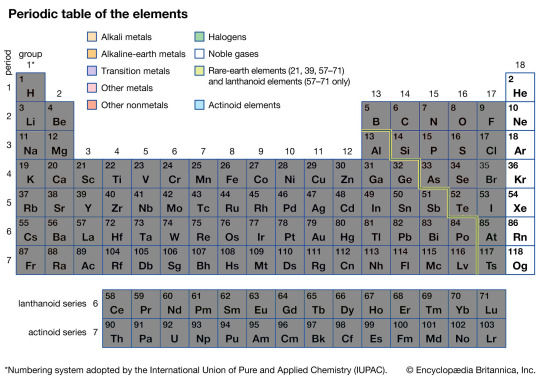
The Nobel Gases
The Nobel Gases like any true Nobels with wealth and status don't like to get involved in the common peasantry's squabbles. In the world of chemicals and elements, this means their full valence electron shells don't stubbornly refuse to chemically react with any other element, and the compounds they do form are often unstable and want to fall apart back into a Nobel Gas and whatever common element it wound up stuck with.
While this lack of reacting does make them rather boring from a reaction perspective, it does make them extremely useful when you do not want things chemically reacting by acting as a buffer between other elements; most easily seen in high end car lights, often filled with Xeon or other Nobel Gases to make sure no matter how hot the light gets it doesn't react chemically and degrade.
Along with protecting lights, they can also be used for lights. Due to their unreactive nature in even high energy environments, it makes them perfect to be used to fill a sealed glass tube that has power shot through it; otherwise known as a Neon Light. However despite the name, not all Neon Lights are filled with Neon, only the orange-red ones are. Other colors such as blues and greens come from the other Nobel Gasses depending on their spectrum emissions.
And on light and degradation, last but not least we have,

The Rare Earth Metals
The Rare Earth Metals can be and often are split into two smaller groups, the upper Lanthanide series and the lower Actinide series.
The upper Lanthanides are all rather chemically similar, meaning they can often be treated somewhat interchangeably in a chemical sense. Their most notable use is without a doubt their ferro magnetic properties, making some of the most powerful magnets on Earth barring electro-magnets. Neodymium magnets are by far the most famous of them, being known to be able to leap across across tables and smash fingers if not handled carefully, while holding up hundreds of pounds of weight.
In contrast, the lower Actinide series is the domain of many of the Radioactive elements and sees the boundary line between the natural and artificial elements. All of them are radioactive to various degrees with decreasing half life lengths.
It is here Thorium and Uranium is found, being the heart of both terrifying bombs and the cleanest sources of energy known to mankind. Beyond Uranium, all the elements are artificial and must be made by humans in breeder reactors.
Despite their association with atom bombs and nuclear reactors, many of these elements also have far more mundane uses. Americium is used in common household Smoke Detectors, saving untold numbers of lives and dollars in property through early warnings of smoke and fire. Other ones are used by NASA and other space agencies in Radioisotope thermoelectric generators or R.T.G.s, used to power spacecraft like Voyager 2 and the Mars Curiosity Rover thousands of miles away from Earth where conventional solar panels would be too heavy, unwieldy, and inefficient so far away from the Sun.
#periodic table of elements#science#elements#chemistry#chemical elements#periodic table#science stuff#science side of tumblr
152 notes
·
View notes
Note
Drop some cool college knowlege on us!
(Tell me about the environment or somethin, this is your excuse to info dump:))
:D Aw thanks Violet.
One of my favorite subjects right now is Soil Science! I think it’s a really cool subject :)
Every soil on Earth has Soil Horizons and these show its history and life cycle through the millions of years it was formed!

The O Horizon, is composed of >20% organic matter(OM) and is quite uncommon as it takes a long time to accumulate OM. The arctic and far north landmasses are more likely to have deep O Horizons because the cold weather keeps organic matter from decaying rapidly! You ever hear of those peat bogs?

That’s hundreds, possibly thousands of years of organic matter stacked up on top of each other.
But what about Tropical Regions? Shouldn’t they have a ton of Organic Matter buildup too? Surprisingly no! It’s quite shallow and nutrient poor. This is because the high temperatures and humidity degrade the organic matter so fast! And the high amount of rainfall washes a lot of the nutrients out of the remaining soil. Plants in these areas are well accustomed to this cycle.

Here’s a soil profile from Ecuador, South America. Do you notice how red it is? That’s rust!
Soils contain lots of minerals like aluminum and iron (although it’s hard to see). And because these tropical areas get pelted by rain, the soil oxides just like a rusty car!
There are all kinds of soil colors too!

Isn’t it wonderful!?
That concludes soil talk :) thank you for reading
61 notes
·
View notes
Text
Wrote a long one cos the in law family wanted him to take the flu shot, I said no.
"Dear Family, Friends, and Medical Professionals,
I am writing to share some thoughts and questions about vaccines, particularly in light of recent developments.
Do we believe that vaccines are the ultimate solution in medicine?
It is commonly known that influenza vaccines are reformulated each season due to the virus’s constant mutation, making it challenging to predict and protect against new strains accurately.
Is it true that these vaccines bypass the liver’s natural filtration system, potentially causing a shock to our bodies?
How should we classify these ingredients—as toxic or benign?
Here are just some vaccine ingredients, and these are being injected into your body and into your children’s bodies if you choose to vaccinate:
– Formaldehyde/Formalin – Highly toxic systemic poison and carcinogen.
– Betapropiolactone – Toxic chemical and carcinogen. May cause death or permanent injury after very short exposure to small quantities. Corrosive chemical.
– Hexadecyltrimethylammonium bromide – May cause damage to the liver, cardiovascular system, and central nervous system. May cause reproductive effects and birth defects.
– Aluminum hydroxide, aluminum phosphate, and aluminum salts – Neurotoxin. Carries risk for long-term brain inflammation/swelling, neurological disorders, autoimmune disease, Alzheimer’s, dementia, and autism. It penetrates the brain where it persists indefinitely.
– Thimerosal (mercury) – Neurotoxin. Induces cellular damage, reduces oxidation-reduction activity, cellular degeneration, and cell death. Linked to neurological disorders, Alzheimer’s, dementia, and autism.
– Polysorbate 80 & 20 – Trespasses the blood-brain barrier and carries with it aluminum, thimerosal, and viruses; allowing them to enter the brain.
– Glutaraldehyde – Toxic chemical used as a disinfectant for heat-sensitive medical equipment.
– Fetal Bovine Serum – Harvested from bovine (cow) fetuses taken from pregnant cows before slaughter.
– Human Diploid Fibroblast Cells – Aborted fetal cells. Foreign DNA has the ability to interact with our own.
– African Green Monkey Kidney Cells – Can carry the SV-40 cancer-causing virus that has already tainted about 30 million Americans.
– Acetone – Can cause kidney, liver, and nerve damage.
– E. Coli – Yes, you read that right.
– DNA from porcine (pig) Circovirus type-1
– Human embryonic lung cell cultures (from aborted fetuses)
You can view all of these ingredients on the CDC’s website. I encourage everyone to do their own research. Look up the MSDS on these chemicals. Read the thousands of peer-reviewed studies that have evaluated the biological consequences these chemicals can have on the body, especially when being injected.
Injecting foreign substances directly into the bloodstream—viruses, toxins, and proteins—has been linked to various diseases and disorders. These include conditions like atypical measles, cancer, leukemia, multiple sclerosis, and even SIDS (Sudden Infant Death Syndrome).
Conditions like Addison’s disease, anaphylactic shock, arthritis, asthma, asymptomatic COVID-19, Crohn’s disease, epilepsy, facial paralysis, fibromyalgia, fetal distress syndrome, foreign body embolism, genital herpes, hepatitis, hyperthyroidism, inflammatory bowel disease, jugular vein embolism, lung abscess, lupus, meningitis, MERS-CoV test positive, migraine-triggered seizures, multiple organ dysfunction syndrome, multiple sclerosis, multisystem inflammatory syndrome in children, pneumonia, stiff leg syndrome, stiff person syndrome, stillbirth, sudden heart attack, sudden respiratory failure, type 1 diabetes, uterine rupture, viral bronchitis—and much more.
This does not mean everyone will experience these reactions, but a significant number of test subjects have experienced one or more.
It is more than enough evidence to show that vaccine mandates are completely anti-scientific.
How can you make an informed decision if you do not have all the information?
We have also seen a shift where flu vaccines are now mRNA-based. But does a "vaccine" really prevent a virus or its recurrence as we expect it to?
The annual flu shot is, at best, a partial defense, aimed at last year’s strain. Does it truly help against the ever-mutating new flu, or is it just a temporary fix?
My concern is that this mindset—that a vaccine is a quick fix for everything—is flawed. The immune system may struggle to handle these types of agents, leading to breakthrough infections and potentially higher mortality rates.
For those who are vaccinated, I respect your choice. I simply ask for the same respect in return for my decision not to vaccinate. My reasons are personal and grounded in a belief that the government should not dictate my health choices and my family's.
Have you heard about Pfizer’s side effects?
Have you read the Pfizer documentation? Ask yourself if a drug with 32 pages of side effects is right for you.
The list of potential vaccine side effects released by Pfizer is alarming, ranging from autoimmune disorders to serious conditions like multiple organ dysfunction and sudden respiratory failure. Yet, this information was kept under wraps and only recently made public. Shouldn’t we be informed of the risks?
Do we even know the medium- or long-term effects of these vaccines?
Are they still in clinical trials? Is there a control group? What about Antibody-Dependent Enhancement (ADE) – has it been adequately tested? And why are ingredients like formaldehyde and mercury, known toxins, included in these vaccines?
Do you truly think this vaccine is 100% safe?
Transparency is crucial.
How can we make informed decisions if we are not given all the information?
We must ask ourselves, do we trust the pharmaceutical companies and their relationships with organizations like the CDC and FDA?
The FDA requested 75 years to release data on the Pfizer vaccine—why? Why did it take only 108 days to approve this vaccine, yet it supposedly requires decades to fully understand its effects?
Do you believe that SARS-CoV-2 has been isolated?
How well-informed are you about the CDC, FDA, pharmaceutical companies, and their donors? Do you think their qualifications are reliable?
These are important questions that deserve honest discussions. And, I believe it is crucial to acknowledge the existence of these alternative perspectives and engage in open discussions to gain a more comprehensive understanding.
Our health and freedom are at stake, and I urge everyone to think critically and seek out all the information before making decisions.
Thank you for taking the time to consider these points."
#vaccine questions#in laws family#we said no#stop using coercion#dont make me burn you#do your research people
12 notes
·
View notes
Text
shared with the Good News App // goodnews.eu
A team of engineers at Nanjing University, working with a pair of colleagues from the University of California, Berkeley, has developed a new way to extract lithium from briny water.
...
Lithium is in high demand due to its use in batteries. Unfortunately, its traditional sources, hard rock ores, are expected to decline in the coming years. Because of that, scientists have been looking for other sources like briny water found in the world's oceans. Prior research has suggested there is more than enough to meet global demand for as long as needed.
The problem is extracting the lithium in a way that does not pollute the environment and is relatively inexpensive to obtain. In this new effort, the research team has developed an approach called solar transpiration-powered lithium extraction and storage (STLES). The idea behind the new approach involves using sunlight to extract lithium from brine. It calls for creating a device that floats on the brine's surface. Inside the device is a membrane made of aluminum oxide with embedded nanoparticles. When the sun shines on the devices, pressure builds up that forces lithium through the membrane, separating the ions from the brine—a silica ceramic frit with tiny holes in it that stores the lithium salts as they are pulled out. The researchers note that because the system operates passively, it is very inexpensive. They also note that it can be used in places besides the ocean, such as the Dead Sea.
8 notes
·
View notes
Note
Do you prefer fountain pens made from metal or plastic? Or is there no difference? I really love the look of safari pens but I'm hesitant to spend so much on a plastic pen body
i actually prefer plastic and resin bodied pens! metal pens are usually too heavy for me and my little hands (part of why i like fountain pens is because ive got joint problems and chronic pain/fatigue so i don't want to press down hard on the page) and also i usually don't really like the handfeel of metal pens. tbh my one exception that i really wanna own is the brass kaweco sport since i could write with it unposted and not have all that weight hanging off the back + the texture of it looks so niceys/it does that cool thing where it oxidizes to your specific hand etc. hehe
my lamy pens feel fantastic in hand and i really like the materials they use! they're a very nice texture and i don't feel like i'm gonna break them or anything from regular use. they sort of engage the same part of my brain that as a kid was satisfied playing with shape sorting toys and lego (which makes sense since they're the same type of plastic!)
if you're really wanting a metal one tho there is the LAMY al-star! it's the same thing as the safari but it's aluminum :) the finish and available colours arent as appealing to me but they might appeal to you!!
#i mention lamy being made of lego plastic like everytime but its just special and cool to me#a well made well designed pen is still gonna feel fancy and longlasting even if its plastic!#fountain pen posting#autismposting
11 notes
·
View notes
Text
Napoleon's Marshals and their Birthstones Part 1
This is a three-part series where I'll be listing the birthstones of all 26 marshals. Part one will cover months January-April, the next post will cover March-August and the last post will cover the remaining 4 months. I'll mainly be focusing on the gemstone's physical and chemical properties as well as writing "short" facts about each gemstone. Before starting the list, I'll provide the definitions of some terms that will be used through the post.
_________________________________________________
Mineral: A naturally occurring solid which contains a crystalline structure that is made up of a single native element or multiple chemical compounds.
Mohs Scale: A scale system used to measure the scratch resistance of a mineral ranging from 1 (softest) to 10 (hardest). This is done by scratching a mineral with another mineral or with another object like a penny or nail.
Cleavage: The way in which a mineral breaks along the softest plane. Classification of a cleavage ranges from perfect, good, poor, indistinct, to none. A mineral can have a basal, prismatic, cubic, rhomboherdal, octahedral, or dodecahedral cleavage.
Fracture: The texture or shape of a mineral's surface. Some types of fractures are described as conchoidal (ripples), earthy (resembles broken soil), hackly (jagged fractures), uneven, and splintery (resembles splinters).
Luster: The way which light reflects off of a mineral. Minerals can have vitreous (glassy), dull (earthy), adamantine (shiny), greasy, silky, metallic, non-metallic, pearly, resinous, or waxy lusters.
Streak: The color of the powder left behind by a mineral when it is scratched on a piece of unglazed porcelain. The color of the powder is usually different from the mineral's color.
Now, onto the list!!
-------------------------------------------------------------
Garnet (January)
Marshals-Ney and Bernadotte
Type: Mineral
Group: Silicate (SiO₄)₃
Color: red, orange, pink, green, yellow blue (rare)
Cleavage: Indistict
Fracture: Conchoidal to uneven
Mohs Scale: 6.5-7.5
Luster: Vitreous
Streak: White
Fun Fact: Garnet is its own family that contains six main species divided into two groups: pyrope, almandine, and spessartine species, which are part of the aluminum group (aluminum is present in its structure). Colors in the Aluminum group range from red to pink; these are the garnet species people think of when looking for jewelry. When pyrope is mixed with almandine, it creates rhodolite, and when mixed with spessartine, it creates malaya. Grossular, uvarovite, and andradite species are part of the calcium group (Calcium is present in structure) and are composed of green to yellow garnet. Uvarovite is the rarest of the calcium group because it grows in small chunks, making it hard to work with when making it into a gemstone.
Amethyst (February)
Marshals- Mortier
Type: Mineral
Group: Silicate (SiO₂)
Color: Purple to Violet
Cleavage: Indistict to none
Fracture: Conchoidal
Mohs Scale: 7
Luster: Vitreous
Streak: White
Fun Fact: Amethyst is part of the quartz family and it used to be part of the cardinal or most valuable gemstones, along with diamonds, rubies, and sapphires, because it was available in small amounts. Its value dropped after large deposits were discovered in Brazil during the 18th century, making it one of the more affordable gemstones.
Aquamarine (March)
Marshals- Brune, Murat, Soult, Suchet
Type: Mineral
Group: Beryl (Be₃Al₂Si₆O₁₈)
Color: Pale blue, light green, bluish-green, sometimes yellow
Cleavage: Indisticnt to none
Fracture: Conchoidal to uneven
Mohs Scale: 7.5-8
Luster: Vitreous
Streak: White
Fun Fact: Aquamarine got its name because its color resembles the sea. It contains small traces of iron, which (depending on the oxidation state) can change its bluish color to green or yellow. These oxidation states are ferrous iron, which gives Aquamarine its blue color, and ferric iron, which gives it a greenish/yellowish color. Heating the mineral removes the greenish color to restore its blue color[1]. Aquamarine also has weak to moderate flourescent properties under UV light [2].
Diamond (April)
Marshals- Jourdan, Lannes, Oudinot, and Saint-Cyr
Type: Mineral
Group: Native mineral (Carbon (C))
Color: Yellow, brown, gray, white, colorless,
Cleavage: Octahedral, Perfect on all sides
Fracture: Uneven
Mohs Scale: 10
Luster: Adamantine
Steak: Colorless
Fun Facts: Diamonds are formed within the Earth's mantle when carbon-rich materials or carbon dioxide are subjected to extreme temperatures and pressure. It reaches the surface via volcanic eruption and gets trapped inside igneous rocks after the magma cools off. The formation of diamonds takes thousands of years, contributing to their high value [3]. Diamonds seen as potential gemstones have little to no impurities or foreign objects within their structure. In contrast, diamonds with high impurities, irregular shapes, and defects are used in commercial industries due to their durability and hardness. Diamonds are the hardest minerals, and are very difficult to scratch or break, but it's not impossible to do so. They also has a high dispersion of white light that creates a rainbow-like effects, also known as 'fire.[4]'
--------------------------------------------------------------
Sources
Garnet: King, H. M. (n.d.). Garnet. geology. https://geology.com/minerals/garnet.shtml
Amethyst: Geary, T.F.; Whalen, D. (2008). The Illustrated Bead Bible: Terms, Tips & Techniques. Sterling Pub. p. 69.
Aquamarine: [1]King, H. M. (n.d.). Aquamarine. geology. https://geology.com/gemstones/aquamarine/
[2]MAT, M. (2023, June 3). Aquamarine: Properties, formation, occurrence " Gemstone. Geology Science. https://geologyscience.com/gemstone/aquamarine/?amp
Diamond: [4]King, H. M. (n.d.). Diamond. geology. https://geology.com/minerals/diamond.shtml
[3]MAT, M. (2023, September 25). Diamond: Properties, formation, occurrence, deposits. Geology Science. https://geologyscience.com/minerals/diamond/
#napoleonic era#napoleon bonaparte#french history#napoleon's mashals#rocks and minerals#gemstone#birthstones#napoleonic wars#sorry for this VERY long post but I had to share my new project of cataloging all of the marshal's birthstones 🥲#I'm dedicating part of my winter break to research minerals and crystals just because :)
26 notes
·
View notes
Text
Chapter 222 Trivia (Part 1)
Fun fact: this chapter is from issue #2 of WSJ's 2022 collection!

The Apollo mission had spacesuits tailor-made to each astronaut, but these days it's easier to use interchangeable parts and switch them out according to the size of the wearer, rather than having the whole suit fitted.
However, the gloves are always custom-sized for dexterity.


Vinyl fabric doesn't seem to have ever been used as part of a spacesuit, however spandex and nylon have, especially in the inner layers.
Outer layers include Teflon, Kevlar, and aluminized Mylar.
It's possible that rather than being used for the fabric, the vinyl is used for the suit's interior cooling tube system, and the aluminum is used for the Mylar rather than for the exterior metal parts, as pure aluminum is easily scratched.


You probably recognize this panel from the end of chapter 219. The only difference is Ryusui's head has been swapped with Stanley's.


Japanese doesn't have a "V" sound, which is why Chrome says "by" rather than "vi" or "vy".
Generally English words used in Japanese make this switch, for example "violin" becoming "baiorin" due to the lacking of "V" and "L" sounds.

This building may be where they're assembling the SENKU 11 rocket, however in this first panel it appears completed, but in later ones it's still under construction.
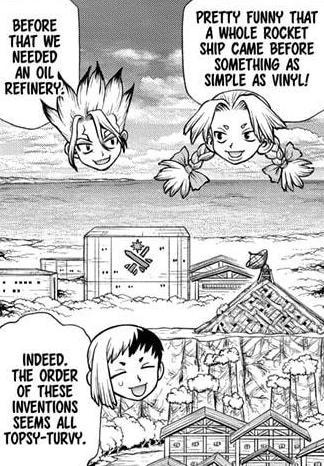
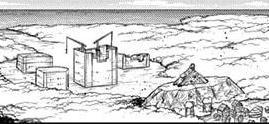
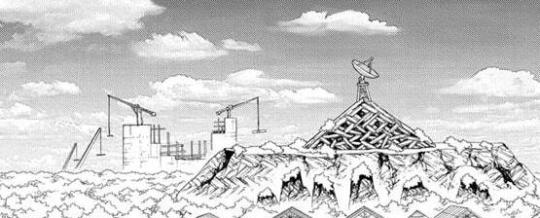
The PS5 was first announced in April 2019, and released November 2020. First images of the console were revealed on June 11th 2020.
The first global petrification happened in June 2019, so this person would know about the console but not known what it was meant to look like.


The robot maid request is most likely a reference to "Me and Roboco", another manga currently being published in Weekly Shonen Jump alongside Dr. Stone. It's a comedy series that follows a powerful-but-clumsy maid robot in a grade schooler's service.
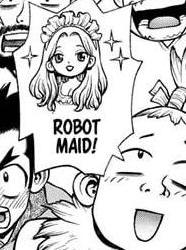
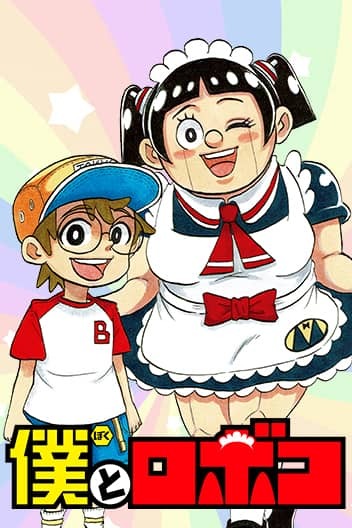
(Later, Me and Roboco came out with a Dr. Stone parody for the 15th volume cover)
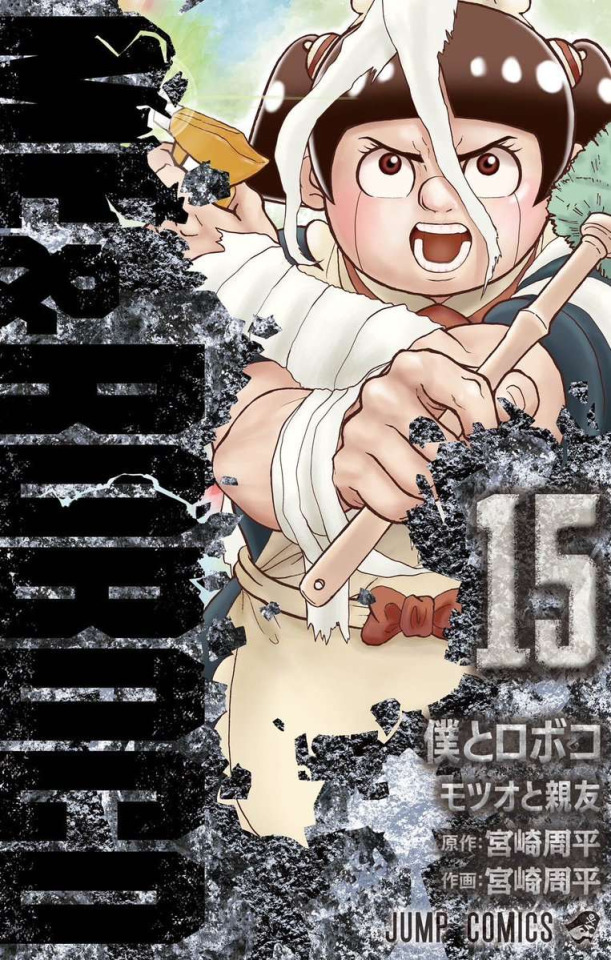
The vacuum tubes are back in the form of cavity magnetrons. These produce the microwaves that bounce around the microwaves' interior body.
The cooking effect was first discovered in 1945 when Percy Spencer noticed a candy bar had melted in his pocket after testing magnetrons.

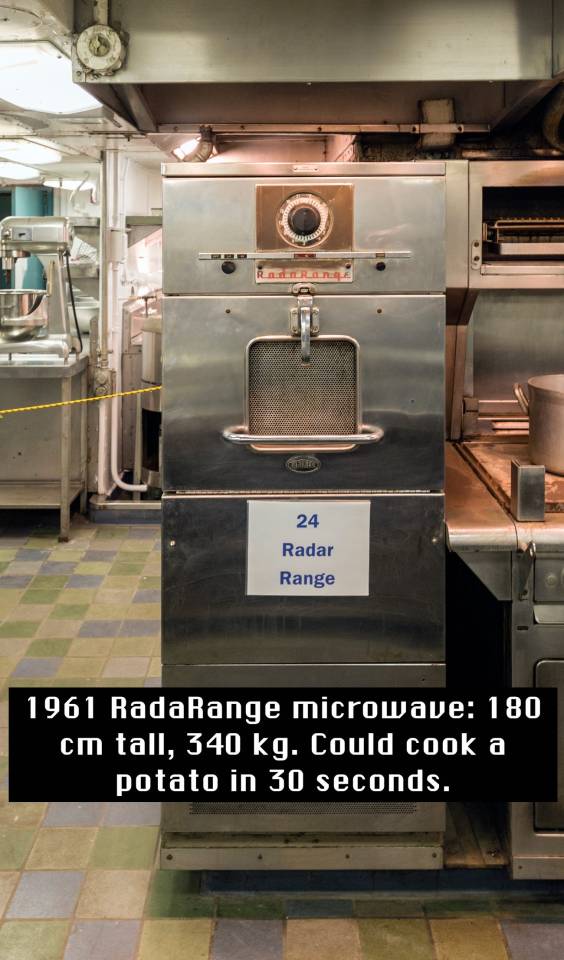
Plastic wrap is vinyl that has been flattened to between 8-12 μm thick, (approximately 0.001 cm). For context, this is about as thick as a spider's web or the size of a droplet of water in fog.


The film Senku makes here is cellulose triacetate film, which is less flammable than earlier celluloid film, earning it the nickname "safety film".
The 8 mm part is the width of the film strip.
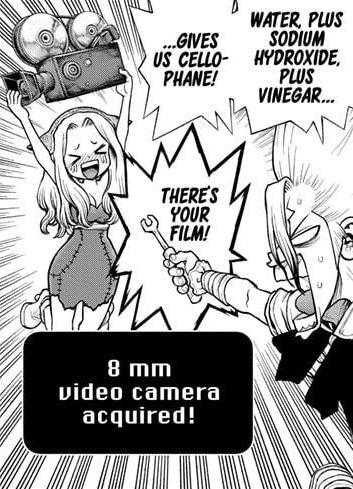
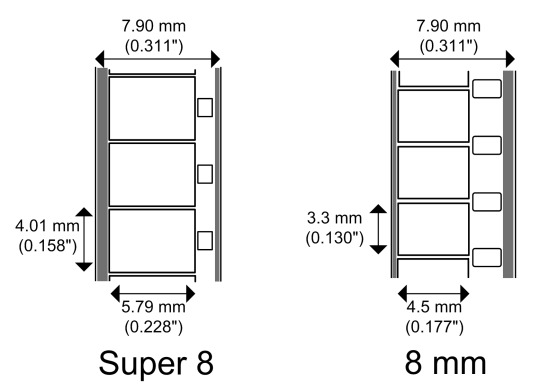

Unlike reusable hand-warmers that use supersaturated sodium acetate, these are one-time use and rely on oxidation to create heat. Once the packaging is opened, air penetrates the bag, oxidizing the iron. Vermiculite is added to remove moisture & salt is added as a catalyst.


Chrome's design wouldn't work properly because he uses iron sand rather than iron powder. Iron sand is mostly magnetite, which is already an iron oxide and thus won't have the oxidation reaction or create heat.

The fridge (or maybe mini wine cellar/fridge?) design is a parody of Smeg, a kitchen appliance brand.
You can also see the Senku-brand PlayStation, robot maid, and protein powder.
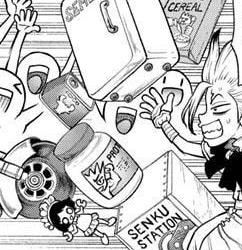

(Next part)
18 notes
·
View notes